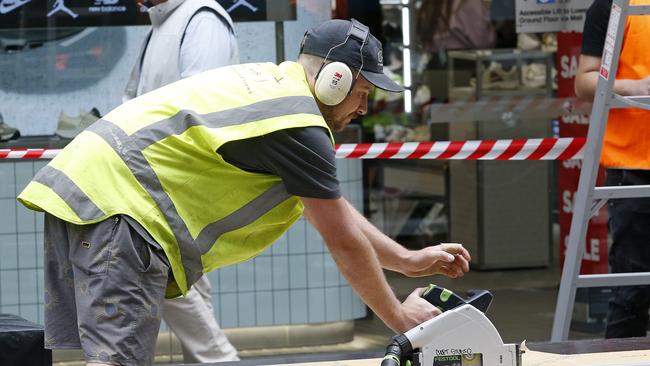NAB pushes forecast interest rate cut to May as RBA issues warning on labour market
NAB has become the first major lender to push back its forecast of an interest-rate cut to May, as Reserve Bank governor Michele Bullock issues a warning on the labour market.

National Australia Bank has become the first major lender to push back its forecast of an interest rate cut to May, as Reserve Bank governor Michele Bullock warns that the labour market remains too tight for the RBA to act, despite job gains easing in October.
Following the release of jobs figures on Thursday that showed the unemployment rate held steady at 4.1 per cent last month, the nation’s second-largest bank jettisoned its prediction of a February rate cut, amid growing expectations Anthony Albanese will head to the next federal election with the cash rate stuck at 4.35 per cent.
The other three major banks – Commonwealth, ANZ and Westpac – are predicting a rate cut in February. CBA had forecast a December rate cut until last month.
Investors have sharply revised their interest rate expectations in the past month, pushing out the timing of a quarter-point cut until August 2025, well after the latest date an election can be held.
While predicting rates will not drop until the RBA’s May 20 meeting – four days before the last possible date for an election – NAB’s head of Australian economics Gareth Spence warned that there was a “real risk that policy rates stay on hold even deeper into 2025”.
“The labour market has been stronger than expected and the RBA remains concerned about upside risks to inflation should gradual labour market cooling stall and capacity growth remain sluggish,” Mr Spence said.
Employment rose by 15,900 last month, falling slightly short of economists expectations of a 25,000 increase, the Australian Bureau of Statistics said on Thursday, while unemployment increased by 8300.
Despite the weaker-than-expected reading, a suite of other labour market indicators remained resilient by historical standards, with the participation rate near a record at 67.1 per cent.
The RBA has pointed to the continued strength of the jobs market as one of the primary reasons the central bank may be forced to resume its aggressive run of rate hikes, having already effectively ruled out cutting interest rates until after Christmas.
Speaking prior to the release of the fresh jobs figures, Ms Bullock said the tight jobs market was still fuelling inflation.
“We still see that in our surveys, in our liaison, that businesses are still saying labour market tightness has eased, but it’s still not easy to get staff,” Ms Bullock told a conference hosted by corporate regulator ASIC in Sydney.
“The strength of the job market is still reflecting the strength we are seeing in demand.”
HSBC chief economist Paul Bloxham said employment indicators suggested that the jobs market was no longer cooling and was likely adding to inflation.
“The RBA has paid close attention recently to the youth unemployment rate and the under-utilisation rate as gauges of the pace of labour market loosening and both suggest the momentum may have stalled,” Mr Bloxham said.
“If it turns out the jobs market is not loosening further, then rate cuts may not happen at all.”
While the RBA expects the key jobless measure will rise to 4.3 per cent by year’s end, before reaching 4.5 per cent by the end of next year, RBC Capital Markets chief economist Su-Lin Ong agreed that the labour market remained healthy. “With just two labour force reports between now and the Feb meeting, it is difficult to see how a clearer sustained weakening trend will emerge,” she said.
The new data prompted Ms Ong to withdraw her February rate cut call, instead pencilling in a quarter-point cut by the RBA in May and warn that a “looser fiscal stance” in the lead-up to the federal election risked prolonging rate relief.
“Political uncertainty will be high in early 2025 (which) probably also argues for the RBA to remain patient,” she said.
Responding to the figures, Jim Chalmers said the jobs market was “softening around the edges”.
“Global uncertainty, higher interest rates and cost-of-living pressures have seen our economy and labour market soften in recent months,” the Treasurer said on Thursday.
However, opposition Treasury spokesman Angus Taylor accused Labor of propping up employment via increased government expenditure which hit a record 27.3 per cent of GDP in the June quarter. “An economy where the jobs market and GDP is entirely propped up by the public sector is not how we should be dealing with the cost-of-living crisis,” Mr Taylor said.
The lion’s share of new hiring in recent months has come from the public sector and other government support roles, with the expansion aided by record government spending.
Released last week, RBA analysis showed jobs growth in the past year had been overwhelmingly driven by employment in the so-called non-market sector covering the public service, healthcare and education.
Approximately 75 per cent of new positions were created in government-aligned industries.
By contrast, employment growth in the private sector has been far weaker, as business has cut back on hiring amid anaemic economic activity.
With analysts also warning that the election of Donald Trump risks keep interest rates higher for longer, Ms Bullock said the central bank would not be “jumping at shadows” in response to the promises of the US president-elect.
“We can’t be setting our policy now on expectations of what we think he might do, because we don’t know,” Ms Bullock said.




To join the conversation, please log in. Don't have an account? Register
Join the conversation, you are commenting as Logout